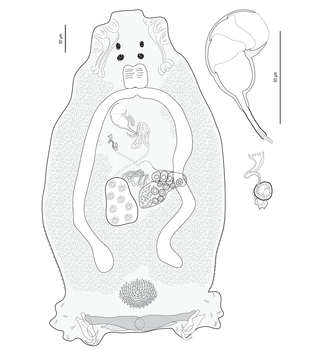Pseudorhabdosynochus auitoe is a diplectanid monogenean parasitic on the gills of the Highfin grouper, Epinephelus maculatus. It was described in 2007.
Pseudorhabdosynochus buitoe is a diplectanid monogenean parasitic on the gills of the Highfin grouper, Epinephelus maculatus. It has been described in 2007.
Pseudorhabdosynochus duitoe is a diplectanid monogenean parasitic on the gills of the highfin grouper, Epinephelus maculatus. It has been described in 2007.
Pseudorhabdosynochus euitoe is a diplectanid monogenean parasitic on the gills of the Highfin grouper, Epinephelus maculatus. It has been described in 2007.
Pseudorhabdosynochus fuitoe is a diplectanid monogenean parasitic on the gills of the highfin grouper, Epinephelus maculatus. It has been described in 2007.
Pseudorhabdosynochus guitoe is a diplectanid monogenean parasitic on the gills of the Highfin grouper, Epinephelus maculatus. It has been described in 2007.
Pseudorhabdosynochus huitoe is a diplectanid monogenean parasitic on the gills of the highfin grouper, Epinephelus maculatus. It was described in 2007.

Pseudorhabdosynochus malabaricus is a diplectanid monogenean parasitic on the gills of the malabar grouper, Epinephelus malabaricus. It has been described in 2007.

Pseudorhabdosynochus maternus is a diplectanid monogenean parasitic on the gills of the Malabar grouper, Epinephelus malabaricus. It has been described in 2007.

Pseudorhabdosynochus manipulus is a diplectanid monogenean parasitic on the gills of the malabar grouper, Epinephelus malabaricus. It was first described in 2007.
Pseudorhabdosynochus cyathus is a diplectanid monogenean parasitic on the gills of the grouper Epinephelus howlandi. It has been described in 2006.
Pseudorhabdosynochus calathus is a diplectanid monogenean parasitic on the gills of the grouper Epinephelus rivulatus. It has been described in 2006.
Pseudorhabdosynochus inversus is a diplectanid monogenean parasitic on the gills of the halfmoon grouper, Epinephelus rivulatus. It was described in 2008, from only three specimens.
Pseudorhabdosynochus quadratus is a species of diplectanid monogenean that is parasitic on the gills of the white-streaked grouper Epinephelus ongus. It was described in 2011.
Pseudorhabdosynochus cyanopodus is a species of diplectanid monogenean that is parasitic on the gills of the blue grouper Epinephelus cyanopodus. It was described in 2008.
Pseudorhabdosynochus podocyanus is a species of diplectanid monogenean that is parasitic on the gills of the blue grouper Epinephelus cyanopodus. It was described in 2008.
Pseudorhabdosynochus crassus is a species of diplectanid monogenean that is parasitic on the gills of the camouflage grouper Epinephelus polyphekadion. It was described in 2011.
Pseudorhabdosynochus dionysos is a species of diplectanid monogenean that is parasitic on the gills of the camouflage grouper Epinephelus polyphekadion. It was described in 2011.
Pseudorhabdosynochus youngi is species of diplectanid monogenean parasitic on the gills of the blacktip grouper, Epinephelus fasciatus. It was described in 2009.
Pseudorhabdosynochus magnisquamodiscum is species of diplectanid monogenean parasitic on the gills of a fish. It was described in 1984 under the name Cycloplectanum magnisquamodiscum and later transferred to the genus Pseudorhabdosynochus.



